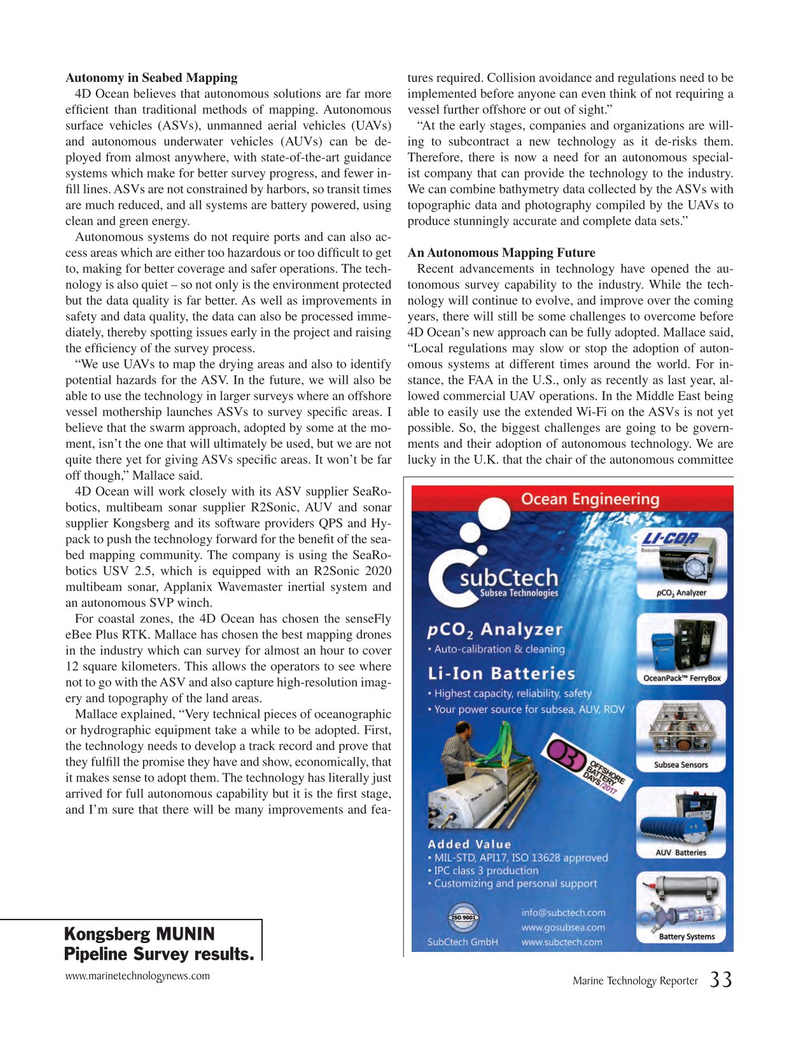
Page 33: of Marine Technology Magazine (June 2017)
Hydrographic Survey
Read this page in Pdf, Flash or Html5 edition of June 2017 Marine Technology Magazine
Autonomy in Seabed Mapping tures required. Collision avoidance and regulations need to be 4D Ocean believes that autonomous solutions are far more implemented before anyone can even think of not requiring a ef? cient than traditional methods of mapping. Autonomous vessel further offshore or out of sight.” surface vehicles (ASVs), unmanned aerial vehicles (UAVs) “At the early stages, companies and organizations are will- and autonomous underwater vehicles (AUVs) can be de- ing to subcontract a new technology as it de-risks them. ployed from almost anywhere, with state-of-the-art guidance Therefore, there is now a need for an autonomous special- systems which make for better survey progress, and fewer in- ist company that can provide the technology to the industry. ? ll lines. ASVs are not constrained by harbors, so transit times We can combine bathymetry data collected by the ASVs with are much reduced, and all systems are battery powered, using topographic data and photography compiled by the UAVs to clean and green energy. produce stunningly accurate and complete data sets.”
Autonomous systems do not require ports and can also ac- cess areas which are either too hazardous or too dif? cult to get An Autonomous Mapping Future to, making for better coverage and safer operations. The tech- Recent advancements in technology have opened the au- nology is also quiet – so not only is the environment protected tonomous survey capability to the industry. While the tech- but the data quality is far better. As well as improvements in nology will continue to evolve, and improve over the coming safety and data quality, the data can also be processed imme- years, there will still be some challenges to overcome before diately, thereby spotting issues early in the project and raising 4D Ocean’s new approach can be fully adopted. Mallace said, the ef? ciency of the survey process. “Local regulations may slow or stop the adoption of auton- “We use UAVs to map the drying areas and also to identify omous systems at different times around the world. For in- potential hazards for the ASV. In the future, we will also be stance, the FAA in the U.S., only as recently as last year, al- able to use the technology in larger surveys where an offshore lowed commercial UAV operations. In the Middle East being vessel mothership launches ASVs to survey speci? c areas. I able to easily use the extended Wi-Fi on the ASVs is not yet believe that the swarm approach, adopted by some at the mo- possible. So, the biggest challenges are going to be govern- ment, isn’t the one that will ultimately be used, but we are not ments and their adoption of autonomous technology. We are quite there yet for giving ASVs speci? c areas. It won’t be far lucky in the U.K. that the chair of the autonomous committee off though,” Mallace said.
4D Ocean will work closely with its ASV supplier SeaRo- botics, multibeam sonar supplier R2Sonic, AUV and sonar supplier Kongsberg and its software providers QPS and Hy- pack to push the technology forward for the bene? t of the sea- bed mapping community. The company is using the SeaRo- botics USV 2.5, which is equipped with an R2Sonic 2020 multibeam sonar, Applanix Wavemaster inertial system and an autonomous SVP winch.
For coastal zones, the 4D Ocean has chosen the senseFly eBee Plus RTK. Mallace has chosen the best mapping drones in the industry which can survey for almost an hour to cover 12 square kilometers. This allows the operators to see where not to go with the ASV and also capture high-resolution imag- ery and topography of the land areas.
Mallace explained, “Very technical pieces of oceanographic or hydrographic equipment take a while to be adopted. First, the technology needs to develop a track record and prove that they ful? ll the promise they have and show, economically, that it makes sense to adopt them. The technology has literally just arrived for full autonomous capability but it is the ? rst stage, and I’m sure that there will be many improvements and fea-
Kongsberg MUNIN
Pipeline Survey results.
www.marinetechnologynews.com
Marine Technology Reporter 33
MTR #5 (18-33).indd 33 MTR #5 (18-33).indd 33 5/24/2017 3:31:12 PM5/24/2017 3:31:12 PM

 32
32

 34
34
